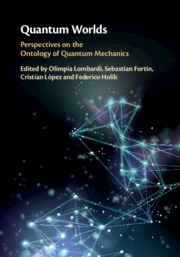Book contents
- Quantum Worlds
- Quantum Worlds
- Copyright page
- Contents
- Contributors
- Preface
- Introduction
- Part I Ontology from Different Interpretations of Quantum Mechanics
- Part II Realism, Wave Function, and Primitive Ontology
- Part III Individuality, Distinguishability, and Locality
- Part IV Symmetries and Structure in Quantum Mechanics
- Part V The Relationship between the Quantum Ontology and the Classical World
- 17 A Closed-System Approach to Decoherence
- 18 A Logical Approach to the Quantum-to-Classical Transition
- 19 Quantum Mechanics and Molecular Structure: The Case of Optical Isomers
- Index
- References
18 - A Logical Approach to the Quantum-to-Classical Transition
from Part V - The Relationship between the Quantum Ontology and the Classical World
Published online by Cambridge University Press: 06 April 2019
- Quantum Worlds
- Quantum Worlds
- Copyright page
- Contents
- Contributors
- Preface
- Introduction
- Part I Ontology from Different Interpretations of Quantum Mechanics
- Part II Realism, Wave Function, and Primitive Ontology
- Part III Individuality, Distinguishability, and Locality
- Part IV Symmetries and Structure in Quantum Mechanics
- Part V The Relationship between the Quantum Ontology and the Classical World
- 17 A Closed-System Approach to Decoherence
- 18 A Logical Approach to the Quantum-to-Classical Transition
- 19 Quantum Mechanics and Molecular Structure: The Case of Optical Isomers
- Index
- References
- Type
- Chapter
- Information
- Quantum WorldsPerspectives on the Ontology of Quantum Mechanics, pp. 360 - 378Publisher: Cambridge University PressPrint publication year: 2019
References
- 1
- Cited by



